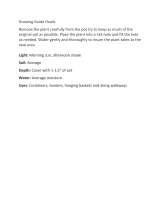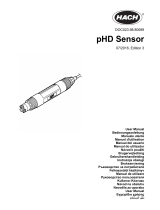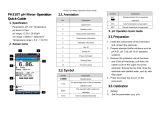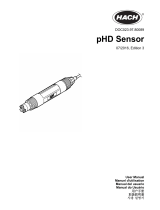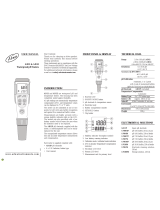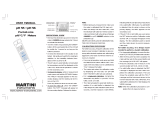
INSTRUCTION MANUAL
HI98168
Professional Soil pH Meter

Thank you for choosing a Hanna Instruments product.
Please read this instruction manual carefully before using the instrument.
This manual will provide you with the necessary information for correct use of the
instrument, as well as a precise idea of its versatility.
If you need additional technical information, do not hesitate to e‑mail us at
[email protected] or view our worldwide contact list at www.hannainst.com.
All rights are reserved. Reproduction in whole or in part is prohibited without the written consent of
the copyright owner, Hanna Instruments Inc., Woonsocket, Rhode Island, 02895, USA.
Dear
Customer,

3
PRELIMINARY EXAMINATION ..............................................................................................
SAFETY MEASURES ............................................................................................................
GENERAL DESCRIPTION ......................................................................................................
FUNCTIONAL DESCRIPTION ................................................................................................
SPECIFICATIONS ................................................................................................................
SOIL pH ............................................................................................................................
ORGANIC SUBSTRATE ........................................................................................................
IRRIGATION WATER ...........................................................................................................
NUTRIENT SOLUTION .........................................................................................................
OPERATIONAL GUIDE .........................................................................................................
pH CALIBRATION ...............................................................................................................
pH BUFFER TEMPERATURE DEPENDENCE ............................................................................
GOOD LABORATORY PRACTICE (GLP) ...................................................................................
SETUP ..............................................................................................................................
LOGGING ..........................................................................................................................
AUTOEND .........................................................................................................................
TEMPERATURE CALIBRATION (FOR TECHNICAL PERSONNEL ONLY) .........................................
PC INTERFACE ...................................................................................................................
BATTERIES REPLACEMENT ..................................................................................................
TEMPERATURE CORRELATION FOR pH SENSITIVE GLASS .......................................................
ELECTRODE CONDITIONING AND MAINTENANCE ..................................................................
TROUBLESHOOTING GUIDE ................................................................................................
ACCESSORIES ...................................................................................................................
TABLE OF CONTENTS
4
4
6
9
13
17
29
31
43
5
8
13
14
19
30
42
44
46
50
51
55
52
56

4
Remove the instrument from the packing material and examine it carefully to make sure that no
damage has occurred during shipping. If there is any damage, please contact your local Hanna
Instruments Office.
Each instrument is supplied with:
•HI12923 Glass body, conical tip, refillable pH electrode with internal temperature sensor
•HI700663 Cleaning solution for soil deposits (1 pc.)
•HI700664 Cleaning solution for humus deposits (1 pc.)
•HI7051M Soil Test Solution (230 mL)
•HI920015 USB cable
•HI721319 ground auger
•pH 4.01 & 7.01 Buffer solutions (230 mL each)
•100 mL Beaker (2 pcs.)
•1.5V AA Batteries (4 pcs.)
•HI720161 Hard carrying case
•Instruction Manual and Quick Reference Guide
•Instrument Quality Certificate
PRELIMINARY EXAMINATION
Note: Save all packing material until you are sure that the instrument functions correctly. All
defective items must be returned in the original packing with the supplied accessories.
SAFETY MEASURES
Before using this product, make sure that it is entirely suitable for your specific application and for
the environment in which it is used.
Operation of this instrument may cause interference to other electronic equipment, requiring the
operator to take steps to correct interference. Any variation introduced by the user to the supplied
equipment may degrade the instrument’s EMC performance.
To avoid damages or burns, do not put the instrument in microwave ovens. For your and the
instrument’s safety, do not use or store the instrument in hazardous environments.

5
GENERAL DESCRIPTION
Other features include:
• Log on demand up to 200 samples (100 pH and 100 mV).
• Auto Hold feature, to freeze first stable reading on the LCD.
• GLP feature, to view last calibration data for pH.
• PC interface.
HI98168 is a portable, pH and temperature meter specifically designed for direct soil measurement.
It is provided with a series of new diagnostic features which add an entirely new dimension to the
measurement of pH, by allowing the user to dramatically improve the reliability of the measurement:
• Seven standard buffers (pH 1.68, 4.01, 6.86, 7.01, 9.18, 10.01 and 12.45) for calibration.
• pH calibration up to five calibration points (see instrument specifications).
• Custom calibration with up to five custom buffers.
• Messages on the graphic LCD for an easy and accurate calibration.
• Cal Check™ Diagnostic features to alert the user when the electrode needs cleaning.
• Optional user enabled “Outside Calibration Range” warning.
• Monitoring of the electrode aging.
• User selectable “Calibration Time Out” to remind when a new calibration is necessary.
This meter is supplied with a pH electrode specifically designed for direct soil measurement.
HI12923 is a glass body, refillable, single junction pH electrode. This electrode has a triple ceramic
junction in the outer reference cell and the conic pH sensing tip is made with low temperature glass.
There is an integrated amplifier and built‑in temperature sensor for automatically temperature com‑
pensated pH readings.

6
1) Liquid Crystal Display (LCD).
2) Functional keys.
3)
/ keys to scroll through calibration buffers, setup options, manual temperature compensation
and logged data.
4) ON/OFF (
) key, to turn the instrument ON and OFF.
5) LIGHT (
) key to toggle display backlighting.
6) GLP key, to display Good Laboratory Practice information.
7) CAL key, to enter/exit calibration mode.
8) SETUP key, to enter/exit SETUP mode.
9) RCL key, to enter/exit view logged data mode.
10) MODE key to change pH resolution.
11) RANGE key, to switch between pH and mV range.
12) HELP key to enter/exit contextual help.
13) ESC to leave current mode, exit calibration, setup, help. etc.
FRONT VIEW
FUNCTIONAL DESCRIPTION
Soil pH Meter

7
14) Electrode quick connect DIN connector.
15) USB connector.
TOP VIEW
FUNCTIONAL DESCRIPTION

8
SPECIFICATIONS
pH
Range ‑2.0 to 20.0 pH / ‑2.00 to 20.00 pH / ‑2.000 to 20.000 pH
Resolution 0.1 pH / 0.01 pH / 0.001 pH
Accuracy ±0.1 pH / ±0.01 pH / ±0.002 pH
Temperature
Range ‑20.0 to 120.0 °C (‑4.0 to 248.0 °F)
Resolution 0.1 °C (0.1 °F)
Accuracy ±0.4 °C (±0.8 °F) (excluding probe error)
mV
Range ±2000.0 mV
Accuracy
0.1 mV
Resolution ±0.2 mV
pH Calibration
Up to five point calibration, seven standard buffers available
(pH 1.68, 4.01, 6.86, 7.01, 9.18, 10.01, 12.45), and five custom
buffers
Slope Calibration From 80 to 110%
Temperature Compensation Automatic
pH Electrode HI12923 pH & temperature
LOG On demand, 200 samples (100 pH and 100 mV)
Input Impedance 10¹² Ω
Battery Type/Life 1.5V AA batteries (4 pcs.) / approx. 200 hours of continuous use
without backlight (50 hours with backlight)
Auto Power Off User selectable: 5, 10, 30, 60 minutes or disabled
PC Interface opto‑isolated USB
Dimensions 185 x 93 x 35.2 mm (7.3 x 3.6 x 1.4”)
Weight 400 g (14.2 oz)
Environment 0 to 50 °C (32 to 122 °F) max. RH 100% IP67

9
pH is the measure of the hydrogen ion concentration [H
+
]. The pH scale goes from 0 (very acidic) to 14 (basic)
with pH 7 being neutral. Soil can be acid, neutral or alkaline.
Fig. 1. shows the relationship between the scale of pH and types of soil. Most plants prefer a pH range from 5.5 to
7.5; but some species prefer more acid or alkaline soils. Nevertheless, every plant has a target for optimum growth.
Fig. 1. Types of soil according to the pH value
pH strongly influences the availability of nutrients and the presence of microorganisms and plants in the soil.
For example, fungi prefer acidic conditions whereas most bacteria, especially those supplying nutrients to the
plants, have a preference for moderately acidic or slightly alkaline soils. In fact, in strongly acidic conditions,
nitrogen fixing and the mineralization of vegetable residual is reduced.
Plants absorb the nutrients dissolved in the soil water and the nutrient solubility depends largely on the pH
value. Hence, the availability of elements is different at different pH levels (Fig. 2).
Fig. 2. Solubility of the elements according to varying pH
SOIL pH

10
Each plant needs elements in different quantities and this is the reason why each plant requires a particular
range of pH to optimize its growth.
For example, iron, copper and manganese are not soluble in an alkaline environment. This means that plants
needing these elements should theoretically be in an acidic type of soil. Nitrogen, phosphorus, potassium and
sulfur, on the other hand, are readily available in a pH range close to neutrality.
Abnormal pH values may increase the concentration of toxic elements for plants. For example, a plant may not
tolerate an excess of aluminum ions that may increase under acidic conditions.
When pH values are too far from neutral conditions a less permeable and more compact soil may result.
A Soil Management Strategy with regard to pH
• It is advisable to choose crops that are suitable for the soils pH range (e.g. in an acid soil, cultivate rice,
potato, strawberry).
• Add fertilizers that do not increase acidity (urea, calcium nitrate, ammonium nitrate and superphosphate)
or lower alkalinity (ammonium sulfate).
• A cost evaluation should be made prior to soil pH modification to determine cost of soil ameliorants versus
value of plants grown.
• pH modification may produce critical improvement in plant performance but may take too long or be short
lived.
For example, by adding lime, the effects in clay soil can last for as long as 10 years, but only 2‑3 years in a
sandy soil.
For an acid soil, we can use substances such as lime, dolomitic, limestone and marl, according to the nature
of the soil. See Table 1.
SOIL pH
Soil Ameliorants Clay soil Silty soil Sandy soil
CaO 30‑50 20‑30 10‑20
Ca(OH)
2
39‑66 26‑39 13‑26
CaMg(CO
3
)
2
49‑82 33‑49 16‑33
Ca CO
3
54‑90 36‑54 18‑36
Table 1. Quantity (q/ha) of pure compound necessary to increase 1 unit of pH.

11
Different naturally occuring minerals may effect soil pH same way but the method for correction may differ.
Take for example elevated soil pH:
‑ Soils rich with limestone:
Add organic matter (non‑organic ameliorants such as sulfur and sulfuric acid might not make economic sense
due to the large quantities needed).
‑ Alkaline‑saline soils:
An appropriate use of irrigation can provide positive results (drop‑irrigation) by flushing out salts.
SOIL pH
Soil ameliorants (pure compounds) Quantity (kg)
Calcium chloride: CaCl
2
· 2H
2
O 85
Sulfuric acid: H
2
SO
4
57
Sulfur: S 19
Iron sulfate: Fe
2
(SO
4
)
3
· 7H
2
O 162
Aluminum sulfate: Al
2
(SO
4
)
3
129
Procedure for direct ground measurement
1) Verify meter is set up correctly and pH electrode is calibrated.
2) Dig, discarding 5 cm of topsoil.
3) Perforate the soil (with HI721319 soil auger) to a depth of about 20 cm or more.
4) If the soil is dry, moisten it with a small amount of distilled water
5) Wash the electrode with tap water (not distilled).
6) Insert the electrode pushing it slightly into the soil to ensure proper contact.
7) Observe the measurement.
8) Wash the electrode with tap water (not distilled) and (using a finger) gently remove any soil remaining
on the electrode (avoid using a rag or cloth).
9) Repeat the procedure in different locations in the field.
10) Consider the average of the measured data.
If alkalinity is caused by sodium, it is recommended to add substances such as gypsum (calcium sulfate), sulfur
or other sulfuric compounds. In this case, a cost evaluation is necessary. See Table 2.
Table 2. Quantities provide the same result as 100 kg of gypsum.

12
For best result, it is advisable to measure the pH of a soil solution, using a sample of soil and soil preparation
solution HI7051; it is better to use this procedure if you have to test a stony field in which you risk damaging
the electrode.
Procedure for the measurement of soil solution (1:2,5)
A) Verify meter is set up corecctly and pH electrode is calibrated.
B) Sampling
1) Extracting Soil Sample.
Take 1 sample per 1000 m
2
(0.25 acre) of homogeneous area.Even for small areas, 2 samples are recom‑
mended (the more the samples, the better the end‑results, because the result is more representative).
2) Avoid extracting samples from soil presenting obvious anomalies and consider them separately.
3) Sample quantity:
Take the same quantity of soil for each sample. For example, use bags with similar dimensions (1 bag per
sample).
4) Depth of extraction:
General: dig and discard 5 cm (2”) of topsoil.
Herbaceous crops: from 20 to 40 cm of depth (8” to 16”).
Orchards: from 20 to 60 cm of depth (8” to 24’’).
5) Spread the soil samples on the pages of a newspaper and let the soil dry in a shady place or put it in an
oven at 40 °C.
6) Crumble the dried soil and mix all the samples together to obtain a homogeneous mixture, discarding stones
and vegetable residues.
7) From this mixture, take the soil sample for analysis.
C) Soil solution preparation and measurement
1) Sift the soil at 2 mm.
2) Weigh 10 g of soil and put it in 25 ml of soil preparation solution HI7051 (use the apposite beaker) or
20 g of soil per 50 ml of soil preparation solution HI7051.
3) Mix for 30 seconds.
4) Wait for about 5 minutes.
5) Mix again and measure the pH of the solution.
SOIL pH

13
The pH measurement of organic substrates is important in greenhouses and nursery growing pots. pH should
be checked at the outset to make sure that the pH of the substrate bought is that desired (pH can change if too
much time elapses from the date of packaging to the moment of utilization).
A) Verify pH meter is set up correctly and pH electrode is calibrated.
B) Direct measurement in pot:
If the substrate is dry, add a little distilled water. Insert the electrode into the soil and take measurement.
C) Measurement of the organic substrate solution (1:2):
Let the substrate dry and discard the coarse vegetable residues and pebbles.
Prepare a solution composed of 1 part of mould and 2 parts of HI7051 solution (for example: fill the beaker
with the substrate up to 50 ml, press it gently, empty the content in another container and add 100 ml of
HI7051 solution).
Mix for 30 seconds and then wait for 5 minutes. Mix again and measure the pH of the solution.
ORGANIC SUBSTRATE
The quality of irrigation water is a very important factor. If the pH value is very far from pH 7, it is possible that
other anomalies are present.
Ranges for evaluation of water quality:
‑ 6 to 8.5 pH: good, it can be utilized without problems.
‑ 5 to 6 pH or 8.5 to 9 pH: sufficient, sensitive crops could have problems.
‑ 4 to 5 pH or 9 to 10 pH: Use carefully, avoid wetting the vegetation/avoid use if possible.
‑ pH<4 or pH>10: Other anomalies that have to be identified via chemical analysis. Do not use for irrigation.
IRRIGATION WATER

14
A rational fertilization program is required for optimum plant growth in greenhouses. The pH value of the nutrient
solution (water + fertilizer) has to meet the plants need.
If a fertirrigation system with automatic pH control is used, ensure that it is functioning properly.
Check the pH of the irrigation solution as well as any recycled solution.
Table 3. tabulates optimum pH value for various plants.
NUTRIENT SOLUTION
ORCHARD PLANTS
Preferred pH Range Preferred pH Range
Apple 5‑6.5 Orange 5‑7
Apricot 6‑7 Peach 6‑7.5
Cherry 6‑7.5 Pear 6‑7.5
Grapefruit 6‑7.5 Plum 6‑7.5
Grapevine 6‑7 Pomegranate 5.5‑6.5
Lemon 6‑7 Walnut 6‑8
Nectarine 6‑7.5
VEGETABLES AND HERBACEOUS CULTIVATIONS
Preferred pH Range Preferred pH Range
Artichoke 6.5‑7.5 Pepper 6‑7
Asparagus 6‑8 Early Potato 4.5‑6
Barley 6‑7 Late Potato 4.5‑6
Bean 6‑7.5 Sweet Potato 5.5‑6
Brussels Sprout 6‑7.5 Pumpkin 5.5‑7.5
Early carrot 5.5‑7 Rice 5‑6.5
Late carrot 5.5‑7 Soybean 5.5‑6.5
Cucumber 5.5‑7.5 Spinach 6‑7.5
Egg Plant 5.5‑7 Strawberry 5‑7.5
Lettuce 6‑7 String 6‑7.5
Maize 6‑7.5 Sugar beet 6‑7
Melon 5.5‑6.5 Sunflower 6‑7.5
Oat 6‑7 Tomato 5.5‑6.5
Onion 6‑7 Watermelon 5.5‑6.5
Pea 6‑7.5 Wheat 6‑7

15
LAWN
Preferred pH Range
Lawn 6‑7.5
GARDEN PLANTS AND FLOWERS
Preferred pH Range Preferred pH Range
Acacia 6‑8 Ligustrum 5‑7.5
Acanthus 6‑7 Magnolia 5‑6
Amaranth 6‑6.5 Narcissus 6‑8,5
Bougainvillea 5.5‑7.5 Oleander 6‑7.5
Dahlia 6‑7.5 Paulownia 6‑8
Erica 4.5‑6 Portulaca 5.5‑7.5
Euphorbia 6‑7 Primula 6‑7.5
Fuchsia 5.5‑7.5 Rhododendron 4.5‑6
Gentian 5‑7.5 Roses 5.5‑7
Gladiolus 6‑7 Sedum 6‑7.5
Hellebore 6‑7.5 Sunflower 5‑7
Hyacinth 6.5‑7.5 Tulip 6‑7
Iris 5‑6.5 Viola 5.5‑6.5
Juniper 5‑6.5
NUTRIENT SOLUTION
HOUSE PLANTS
Preferred pH Range Preferred pH Range
Abutilon 5.5‑6.5 Gardenia 5‑6
African violet 6‑7 Geranium 6‑8
Anthurium 5‑6 Hibiscus 6‑8
Araucaria 5‑6 Jasmine 5.5‑7
Azalea 4.5‑6 Kalanchoe 6‑7.5
Begonia 5.5‑7.5 Mimosa 5‑7
Camellia 4.5‑5.5 Orchid 4.5‑5.5
Croton 5‑6 Palms 6‑7.5

16
Cyclamen 6‑7 Peperomia 5‑6
Dieffenbachia 5‑6 Philodendron 5‑6
Dracaena 5‑6 Yucca 6‑7.5
Freesia 6‑7.5
Table 3. Optimum pH for various Plants.
NUTRIENT SOLUTION

17
OPERATIONAL GUIDE
INITIAL PREPARATION
The instrument is supplied complete with 1.5V AA (4 pcs.) batteries. For placing the batteries inside
the meter, see page 50.
Make sure that the protective micro USB cover is used when not connected to a computer to ensure
waterproof protection.
For HI98168 connect the pH/temperature electrode to the DIN connector.
Turn the instrument ON by pressing ON/OFF key.
At start‑up the display will show the Hanna Instruments logo for a few seconds followed by the
percentage indication of the remaining battery life, then enters the measurement mode.
After measurement switch the instrument off, clean the electrode and store it with a few drops of
HI70300 storage solution in the protective cap (see page 53).
The Auto Power Off feature turns the instrument off after a set period (default 30 min) with no button
pressed to save battery life. To set another period or to disable this feature, see SETUP menu on
page 31.
The Auto Light Off backlight feature turns the backlight off after a set period (default 1 min) with
no buttons pressed. To set another period or to disable this feature, see SETUP menu on page 31.
pH MEASUREMENTS
To take a pH measurement remove the electrode protective cap and simply submerge the tip of the
electrode (4 cm/1½") into the sample to be tested.
Press RANGE key to choose between pH and mV ranges.
Use MODE key to select the pH resolution.
Allow time for the electrode to adjust and reading to stabilize (hourglass symbol turns off).

18
OPERATIONAL GUIDE
• pH reading with the selected resolution.
• Temperature reading in the selected unit (°C or °F).
• Electrode condition during the calibration day.
• The buffers used in last pH calibration (if feature is enabled in SETUP).
• Battery level indicator.
• Available functional keys.
In order to take more accurate pH measurements, make sure that the instrument is calibrated (see
page 19 for calibration details).
It is recommended that the electrode is always kept moist and rinsed thoroughly with the sample to
be measured before use.
The pH reading is directly affected by temperature. For accurate pH measurements, temperature
must be taken into consideration. If the sample temperature is different from the temperature at
which the pH electrode was kept, allow a few minutes to reach thermal equilibrium.
On the pH screen are displayed:
TEMPERATURE MEASUREMENTS
For HI98168 the temperature sensor is connected through DIN socket.
Note: The temperature can be displayed in Celsius degrees (ºC) or in Fahrenheit degrees
(ºF) (see SETUP for details, page 31).
BACKLIGHT FEATURE
The instrument is provided with a Backlight feature, which can be easily toggled on and off through
the keyboard by pressing LIGHT.
Note: The backlight automatically shuts off after a set period (see SETUP for details,
page 31) with no buttons pressed.

19
pH CALIBRATION
It is recommended to calibrate the instrument frequently, especially if high accuracy is required.
The pH range should be recalibrated:
• Whenever the pH electrode is replaced.
• At least once a week.
• After testing aggressive chemicals.
• When calibration alarm time out is expired ‑ “CAL DUE” blinks (if feature is enabled in
SETUP).
• If “Outside Cal Range” message blinks during pH measurement (the measurement range is
not covered by current calibration, if feature is enabled in SETUP).
PROCEDURE
HI98168 instrument offers a choice of seven standard buffers (pH 1.68, 4.01, 6.86, 7.01, 9.18, 10.01
and 12.45). The meter allow the user to set up to five custom buffers. The custom buffers are the
buffer values at 25 °C.
When a custom buffer is selected during calibration, the Custom functional key is displayed on the
LCD. Press Custom key in order to enter custom buffer changing mode. Use / keys to change
the value in a ±1.00 pH window, in according with the temperature reading and then Accept. Press
ESC to leave custom buffers value unchanged.
For accurate pH measurements, it is recommended to perform a calibration with buffers that bracket
the expected pH value. At least, two point calibration is recommended.
The instrument will automatically skip the buffers used during calibration and the buffers which are
in a ±0.2 pH window around one of the calibrated buffers.
• Remove protective cap and rinse the electrode with distilled or deionized water.
• Pour small quantities of selected buffers solutions into clean beakers. For accurate calibration use
two beakers for each buffer solution, the first one for rinsing the electrode and the second one
for calibration.

20
pH CALIBRATION
• Press CAL. The instrument will display the measured pH, the LCD first expected buffer and the
temperature reading.
• If necessary, press the / keys to select a different buffer value.
• The “ ” tag will blink on the LCD until the reading is stable.
• When the reading is stable and within range of the selected buffer, CFM functional key is
displayed.
FIVE POINT CALIBRATION
• Immerse the pH electrode approximately 4 cm (1½”) into a buffer solution of your choice
(pH 1.68, 4.01, 6.86, 7.01, 9.18, 10.01, 12.45 or a custom buffer) and stir gently.
• Press CFM to confirm first point.
• The calibrated value and the second expected buffer value is then displayed on the LCD.
Page is loading ...
Page is loading ...
Page is loading ...
Page is loading ...
Page is loading ...
Page is loading ...
Page is loading ...
Page is loading ...
Page is loading ...
Page is loading ...
Page is loading ...
Page is loading ...
Page is loading ...
Page is loading ...
Page is loading ...
Page is loading ...
Page is loading ...
Page is loading ...
Page is loading ...
Page is loading ...
Page is loading ...
Page is loading ...
Page is loading ...
Page is loading ...
Page is loading ...
Page is loading ...
Page is loading ...
Page is loading ...
Page is loading ...
Page is loading ...
Page is loading ...
Page is loading ...
Page is loading ...
Page is loading ...
Page is loading ...
Page is loading ...
Page is loading ...
Page is loading ...
Page is loading ...
Page is loading ...
/
